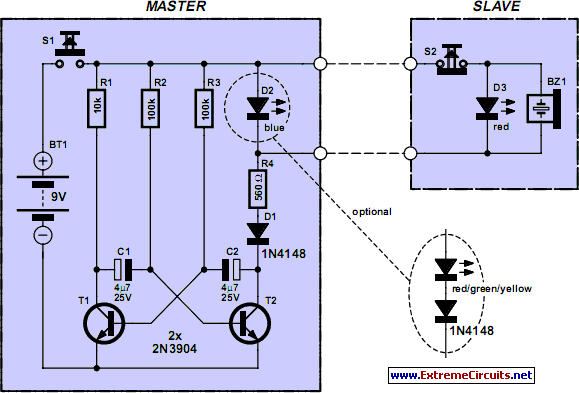Home » Circuits
Call Acknowledged !
This circuit could be used (depending on your circumstances) by a gentleman to summon his butler, a manager his secretary or as in the author’s case to call the kids down to dinner without having to shout above the level of the CD player/TV/games console in their bedroom. Rather than resorting to a full-blown intercom system, a simpler solution was envisaged and while a buzzer could easily fulfil this function, this circuit has the advantage of providing a visual indication of a call as well as confirming to the caller that the ‘message’ has been received.This is especially useful in the latter case, as the call may be easily drowned out by the music playing in the headphones. The circuit, which requires no complicated switching, uses a simple two-wire connection between the two stations and utilises the fact that the forward voltage drop of a blue (or white) LED is greater than that of a red, green or yellow one. The circuit is based on a two-transistor multivibrator which is used to pulse a red LED (D3) as well as the buzzer Bz1 on and off at about 1.5 Hz when push button S1 is closed. This frequency may of course be altered if required by changing the values of the capacitors.
Circuit diagram:
The diode D1 in series with the collector of transistor T2 is required to isolate the output from the effects of the buzzer circuitry, which would alter the multivibrator frequency. In principle, the multivibrator could be dispensed with but a pulsed buzzer/flashing led is much more noticeable than a continuous signal especially in noisy conditions. Since the voltage across a red LED is typically about 1.5 V while a blue LED requires at least 2.5 V to 3 V to light, the blue LED will remain off when the call button S1 is pressed. Despite being rated for operation at 3-12 V, most piezo sounders can still produce a piercing sound from the pulsed 1.5-V available across the red LED which should get the attention of even the most preoccupied teenager.
When the recipient presses the acknowledge (push to break) switch S2, the red LED/buzzer are disconnected allowing the blue LED to flash at the sending station indicating to the caller that his call has been received. Alternatively, if a blue LED is not available, a red or green type in series with a forward biased silicon diode to raise its forward voltage above that of the red LED in the receiver could be used instead. The circuit may be powered by a 9-V battery, a mains power supply being unnecessary in view of the low power consumption and infrequency of use of the circuit.
Author: Bart Trepak - Copyright: Elektor Electronics

